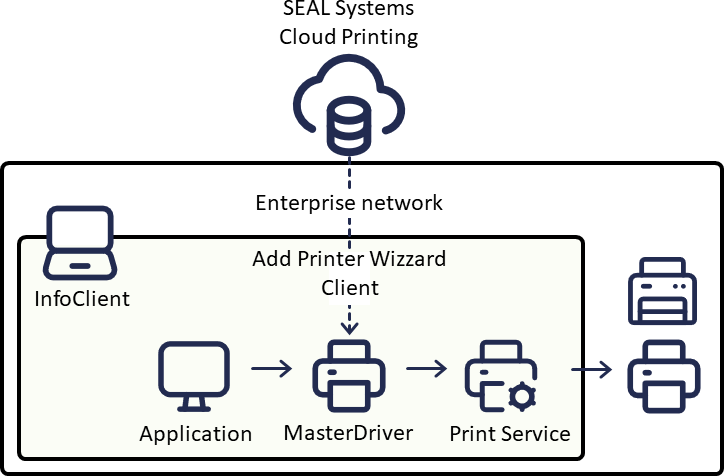In this Article
How are different sites considered in a print concept so far? (STANDARD)
In order for decentralized locations to be able to print documents, local print servers are required on which the printer drivers are stored, and the manufacturer-specific printer drivers must be installed on the client (PC). This enables the user to print from Windows and Office applications. In addition to direct printing, batch printing is also required to automatically print documents from third-party systems, e.g. in the ERP area, logistics and production.
What are the challenges for IT to be able to reduce effort and costs?
In times of cloud computing and similar techniques, server landscapes still have to be operated at branch offices with the previous approach. This costs money for licenses and time for administration. Print servers usually lead a life of their own, meaning that in large IT landscapes, print servers and printers used are no longer known or are intransparent. The consequences are costly! For example, if a new printer tender is to be issued or only the number of printers and their location are to be determined, it is very difficult to get the necessary data to do this.
Is printing without a local print server at different locations conceivable?
To do this, the user would have to be able to connect his client to the desired printer at the site. It is also necessary to improve central management, monitoring and accounting in order to achieve recognizable added value. A prerequisite is the availability of the printing process even if the WAN bandwidth to the branch office is only low or the central IT or cloud should fail.
What does the future hold for output management solutions (OMS) from the cloud?
The output management of SEAL Systems has a clearly structured cloud approach (cloud native) and is operated at the hoster and cloud provider. In addition to the classic scaling effects, failure safety and distributed availability can be definitely ensured. Printing is a sub-area of output management, along with the digital distribution of documents and data. The challenge here is to manage all printers (e.g. workstation, label and multifunction printers).
How does Serverless Printing work in practice?
The solution from SEAL Systems is designed for business and enterprise customers and provides a dedicated print service in the company. In addition to the advantages of an OMS, the SEAL Print Service is made available to the user via software distribution. This includes the following tools for a simple user-self service:
- SEAL MasterDriver, as generic printer driver
- SEAL Add-Printer Wizard, to add printers easily
- SEAL InfoClient, to track jobs
Thus, the user has all centrally managed information about the available printer models and is then able to conveniently print decentrally (without server and without spooling). Print formatting takes place locally on the client. Thus, you are economical with bandwidth and benefit from the advantages of a managed and professional cloud solution.

If the SEAL cloud approach to printing solutions is applied to different locations (Branch Office Printing), several advantages can be exploited at once:
- Central output management in the cloud
- A database for printer queues, key performance indicators (KPIs), reports
- Print service for local clients and batch processes in the cloud
- Generic printer driver for all printers
- Distribution of serverless printing for decentralized operation
- Mixed operation of on-premise (PLOSSYS Print Appliance) and cloud
Printing solutions belong in every cloud strategy. Together with its partners in hosting, cloud operations and IT consulting, SEAL Systems is working on joint solutions.